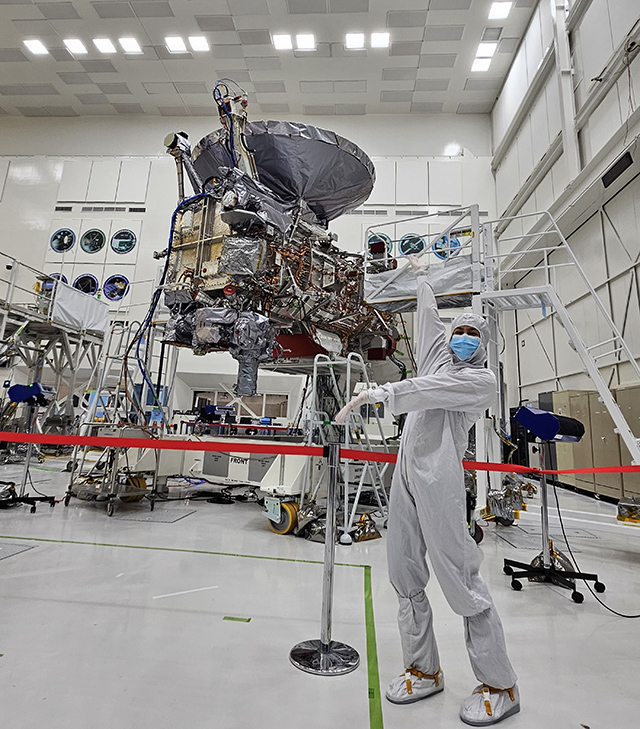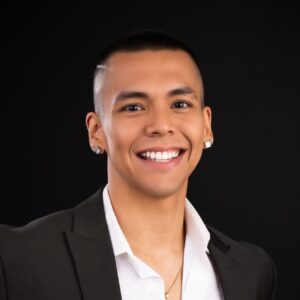
The success of NASA’s exploration of Jupiter’s moon Europa depends, in part, on CSUN alumna Akemi Hinzer’s choice of outfit before she leaves for work.
She must be clean and dressed strategically — she can’t wear, say, ripped jeans or fuzzy sweaters or anything that will shed threads.
When she arrives at the Kennedy Space Center, she dons a mask, a hairnet and a full-body garment called a “bunny suit” — essentially a onesie, Hinzer said — that keeps hair and skin from contaminating the controlled environment where technicians prep the spacecraft for launch. She pulls on big, sturdy boots and thick gloves that are hard to tear, all taped to the suit. She wipes her phone and computer down with alcohol. Lastly, she walks through an “air shower,” which blasts team members with clean air to blow away dust and other contaminants.
Then, she can enter the cleanroom.

Hinzer has a job title fit for an awesome movie: planetary protection scientist. She was promoted from intern to full-time employee in 2022 to work on NASA’s Europa Clipper — a probe destined for one of Jupiter’s myriad moons, Europa, where scientists think conditions might be right to harbor life.
The planetary protection team works to make sure the uncrewed mission doesn’t accidentally leave some life behind on the icy moon.
“We’re trying to see if this is a place that can support life,” Hinzer said. “If we want to be successful, we can’t go contaminate it with our Earth bacteria.”
Hinzer ’21 (Biochemistry) normally works at NASA’s Jet Propulsion Laboratory (JPL) in La Cañada Flintridge, but in May, she and about 60 colleagues followed the Europa Clipper to the storied Kennedy Space Center in Florida to prepare for the probe’s launch aboard a SpaceX Falcon Heavy rocket. NASA will livestream the launch, which is targeted for the morning of Oct. 10 but could take place as late as Nov. 6.
Playing a critical role in such a high-profile NASA project is an unexpected high point in a career Hinzer, 33, didn’t always envision for herself. She was a nontraditional student who eventually tried college and, the way she tells it, kept getting pressured by professors and classmates into grudgingly applying for opportunities that led her to NASA.
CSUN biochemistry Professor Karin Crowhurst, who worked with Hinzer for three years through the BUILD PODER undergraduate biomedical research program, tells a different version. In Hinzer, she saw a motivated student with innate ability who, like many first-generation students, didn’t know what opportunities and career fields were available to her — but who wisely took advantage when doors opened.
“Research opportunities can be absolutely critical and transformative for students, and this is a perfect example of a success story that comes from it,” Crowhurst said. “Once students realize that they can do this, they take it and run with it, and it’s amazing to see, because it can change the entire course of their lives.”
Shooting the Moon

Life as earthlings know it couldn’t have developed without three ingredients — liquid water, certain chemical elements (like carbon and oxygen), and an energy source (like the sun). Europa, the fourth-biggest of Jupiter’s 95 moons, is covered in thick ice, but scientists believe there’s a vast, salty ocean beneath the surface. The moon could also have the right chemical elements and viable energy sources, such as chemical reactions triggered by the harsh radiation from Jupiter.
The Europa Clipper mission isn’t intended to find life; its purpose is to verify that Europa holds these conditions. If it can, Europa would be the first place in our solar system outside of Earth verified to currently hold conditions suitable for life. This data could inform a future mission to Europa to look for life. It would also mean that there are probably many other worlds hospitable to life.
When flying missions in space — especially to places that likely have hosted life before, like Mars, or could host it now, like Europa — NASA must follow an international treaty to minimize the chances of accidentally contaminating other celestial bodies.
Hinzer’s team is responsible for ensuring the bacteria levels on the spacecraft’s surfaces remain below levels that are as close as possible to a non-zero probability of contamination. Not every microbe is a danger; most couldn’t survive the harsh environments encountered during space travel, Hinzer said. But some bacteria can form bacterial spores — a seedlike structure that might protect them in space until they find a hospitable environment in which to thrive.
“[Bacterial spores] can survive some really horrible environments for years,” Hinzer said.
Accidentally leaving living spores on Europa could contaminate future science, so steps are taken to minimize them by every team through every step of the mission. Hinzer’s Planetary Protection team comes up with a plan and works with other teams from mission partners including NASA, SpaceX and Johns Hopkins University Applied Physics Laboratory to make sure these procedures are followed. A lot of Hinzer’s job is communication, coming up with a reasonable plan and making sure everyone on multiple teams understands what they’re supposed to do.
The Clipper is a huge spacecraft, about the length of a basketball court when deploying its solar array wings that serve as a power source. It’s carrying nine high-tech instruments to take images and measurements, including cameras, a thermal imaging system, and ice-penetrating radar.
The Europa Clipper was first assembled at JPL, then transported to a cleanroom at Kennedy Space Center. Anything brought in — new spacecraft parts, tools, scaffolding, etc. — is cleaned first, with solvents such as isopropyl alcohol, or baked at high temperatures to kill bacteria.
Anything that comes close to the spacecraft gets sampled. Hinzer takes her samples back to the lab and for processing, where they are grown on Petri dishes so she can count them and estimate how many bacteria are on the spacecraft. If there are too many, engineers must clean the area so it can be sampled again, but this rarely happens.
“It’s really, really good. It’s very clean,” Hinzer said of the spacecraft. “It’s so much cleaner than any other environment you have ever encountered in your life.”
The harsh realities of space travel aid in Hinzer’s quest to prevent Earth bacteria from surviving on Europa. There’s the heat of Earth’s atmosphere as the probe leaves, the cold of space, and the thickness of the moon’s ice — and even the extreme amounts of radiation from Jupiter itself.
“On the off chance that something goes terribly, terribly wrong and [Europa Clipper] lands somewhere we don’t want it to, we have such a small, small, small chance of getting anything living from Earth to somewhere we don’t want it,” Hinzer said. “That’s what we’re working towards, always minimizing that risk and reducing that chance.”
To Explore Strange, New Worlds
Europa Clipper is expected to reach Jupiter in 2030. It’ll take a winding journey to get there, flying by Mars in early 2025, and then back by Earth in 2026, using the planets’ gravity to “slingshot” and increase velocity. The probe will orbit Jupiter and capture data during about 50 scheduled flybys of Europa over four years.
Hinzer’s own journey took several twists and turns. She graduated from La Cañada High School, right by JPL, but didn’t envision a career there. She flipped cars as a mechanic, joined her dad on a construction crew, decorated wedding cakes. She didn’t plan to go to college; she thought her life was fine without it.
But about six years ago, Hinzer found herself with an unexpected hole in her schedule. She took a class to fill it. It went well, so she took another.
“And then, I don’t know, I was in too deep,” she said.
Soon, she was on a pre-med track, considering a career as a physician assistant, possibly in hospice care. A community college chemistry professor “absolutely bullied” her into applying for a BUILD PODER research fellowship, Hinzer said. She was accepted, and while still in community college, she began working in Crowhurst’s lab at CSUN.

She learned a lot of skills she employs at NASA in the Crowhurst lab, Hinzer said: following protocols religiously, labeling everything, giving presentations. Hinzer was shy when she arrived at the lab, but with time, she grew to be a great communicator. In 2021, her hard work was recognized with CSUN’s Weigand-Jewett Award for Outstanding Senior in Biochemistry scholarship.
Peer pressure also led Hinzer to NASA, she said. One of the members of her BUILD PODER cohort convinced her to apply for a workshop held by members of JPL’s planetary protection group which featured CSUN biology Professor Rachel Mackelprang as a guest speaker. Until that point, Hinzer hadn’t realized that NASA needed biochemists.
Connections Hinzer made in the bioinformatics workshop led to an internship in July 2021, analyzing unprocessed metadata collected by the planetary protection team ahead of the 2020 Perseverance Rover mission to Mars. The internship was supposed to last six weeks, but JPL colleagues extended it until she was hired full-time in her current role in late 2022.
Hinzer is among the many CSUN alumni who have gone on to work as permanent employees of JPL. CSUN’s relationship with JPL goes back decades, as students, faculty and alumni from the College of Science and Mathematics and the College of Engineering and Computer Science, including the Autonomy Research Center for STEAHM and its partners across campus, have collaborated on projects with JPL.
Full Circle
Hinzer twice has returned to CSUN to help lead the bioinformatics workshop that initially connected her to JPL.
“It was kind of full circle,” Hinzer said. “Some of the people that I was in BUILD with were now grad students in labs, and were part of this workshop, and that was fun.”
Soon, Hinzer’s life is going to change. She’s not sure what her next mission will be — she can participate in research, or work with other NASA teams. Whatever’s next, it’s likely her deadlines won’t be as urgent as they have been this year — unless she joins up with another high-profile project.
The rapid approach of the Europa Clipper launch evokes some bittersweet emotions for her. This chapter of an unexpected journey is coming to an end.
“This always felt out of reach. This was not on my to-do list,” Hinzer said. “I’m having so much fun — I’m way too frantically busy to consider otherwise.
“I got hired at JPL specifically to work on this mission, and so this is almost all I’ve ever done at JPL,” she continued. “There’s such a steep learning curve, and now that I feel like I’m getting the hang of it, it’s gonna leave the planet. I’m heartbroken already, but very excited.”




Comments are closed.